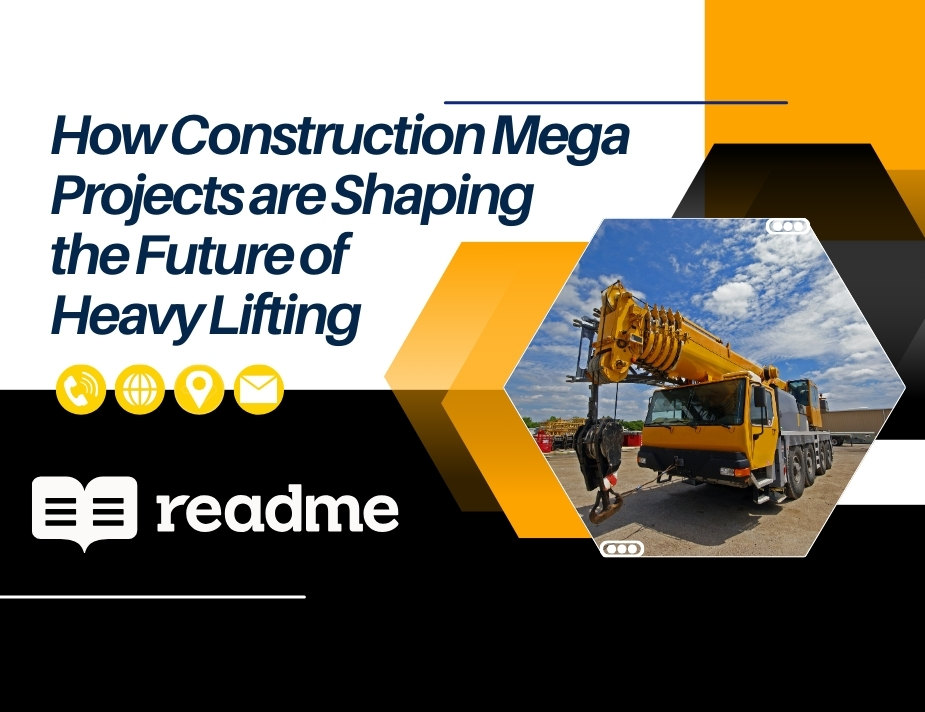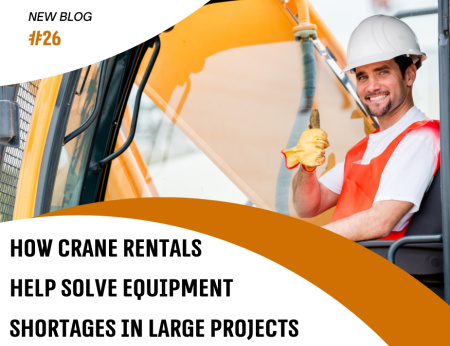MYCRANE WORLD
Join the Future of Cranes & Heavy Equipment Trading

How Construction Mega Projects are Shaping the Future of Heavy Lifting
The Increasing Size of International Mega Projects
The term "mega project" grows larger with the ever-expanding ambition of humans that breaks engineering boundaries. Previously, projects with more than $1 billion investment were the norm, but recent times see numerous projects worth more than $100 billion. The Saudi Neom project, for instance, is a record $500 billion undertaking, and China's Belt and Road Initiative includes the construction of infrastructure across several continents costing more than $1 trillion.
These gargantuan projects present specialized challenges to heavy lifting activities:
Never-before-used Structural Components
Megaprojects nowadays often feature unprecedented structural elements and components in size and weight. The Dubai Creek Tower alone's foundation required individual concrete pours larger than 9,000 cubic meters, and specialist heavy lift equipment to put down the weighty hundreds of tons' reinforcement cages. Equally, offshore windfarms today make use of wind turbines' blades measuring more than 100 meters, calling for dedicated lifting arrangements in their installation.
The dimensions of these pieces have necessitated a reconsideration of traditional sequencing in construction. Rather than working on smaller pieces on site, mega projects now increasingly depend on prefabrication of gargantuan modules, which are shipped and installed as complete pieces. This reduces on-site construction periods but places an astronomical burden on lifting capacity.
Challenging Project Environments
Fr om Middle Eastern desert project extremities to unforgiving offshore settings of oil initiatives, mega projects are increasingly based in environments counter to typical building operations. Heavy lift activities must adapt to poor weather, excessive wind speed, and isolation while ensuring safety and efficiency.
The offshore oil fields of the Caspian Sea, say, have their own specificities in the guise of winter ice structures and howling winds throughout the year. Likewise, urban projects like Tokyo's Sky Mile Tower require close spatial tolerances, which are not easy to operate equipment with. Every situation requires site-specific heavy-lift practices, keeping local conditions and limitations in mind.
Compressed Timelines
Even as they become increasingly complex, most mega projects are under pressure to compress completion timelines. Such compression calls for concurrent heavy lifting operations in several project zones, necessitating increased equipment, improved coordination, and creative lifting techniques.
The economics of mega projects frequently mandate that every day of accelerated completion equals millions in added return on investment. This fact has fueled the growth of around-the-clock lifting activities using multiple crane systems operating in a choreographed sequence. The organization of these operations is a logistical challenge almost as great as the technical lifting requirements themselves.
%20(1).jpg)
Economic Implications of Advanced Heavy Lifting
Heavy lifting technology evolution has significant economic consequences for mega project viability and delivery. High-end lifting solutions allow construction methods that radically change project economics:
Modularization Economics
The ability to lift very heavy prefabricated modules has revolutionized cost structures for the majority of mega projects. By shifting construction activities fr om the field to controlled fabrication facilities:
- Labor productivity improves by 25-50% compared to stick-built construction
- Quality control problems reduce by about 30%
- Weather-related delays can be minimized by as much as 80%
- Overall project schedules can be reduced by 20-30%
For LNG terminals and offshore platforms, wh ere a month of compressed production is worth tens of millions in revenue, such advances enhance the viability and payback on such projects directly.
Risk Mitigation Through Advanced Lifting
The precision and accuracy that is offered by modern heavy lifting equipment greatly reduce project risk profiles. Computer-operated lifts under direct real-time observation greatly reduce the chances of costly accidents that could potentially ruin project schedules and project costs.
Underwriters have started realizing these advantages, with premium savings of 5-15% being provided by some for those projects that feature cutting-edge lifting technologies with high-end monitoring and control systems. These savings are worth millions of dollars on mega projects with billion-dollar budgets.
Revolutionary Heavy Lifting Technologies Emerging in Response
Construction mega projects demand have propelled significant innovation in heavy lifting technology. These advances are not incremental but represent revolutionary changes in the transportation of enormous loads during construction sites.
Ultra-Capacity Cranes
The advent of super-heavy lift cranes with lifting capacities over 3,000 tons has revolutionized the construction industry. Equipment such as the Liebherr LR 13000 crawler crane and Mammoet SK350 ring crane can facilitate the lifting of huge pre-assembled modules, considerably reducing on-site construction periods and enhancing project economics.
The Sarens SGC-250, or "Big Carl" as it is fondly called, is the pinnacle of this innovation. With a 5,000-ton lifting capacity and a working radius of up to 275 meters, this crane is currently employed in the building of the Hinkley Point C nuclear power plant in the UK, wh ere it lifts prefabricated modules weighing as much as a small warship.
These super-capacity cranes realize their amazing abilities by means of innovative engineering strategies:
- Lightweight boom structures that maximize strength at minimum weight
- Advanced hydraulic systems capable of controlling gigantic columns of force
- Advanced counterweighting schemes that achieve ultimate stability under load
- Module construction that can be shipped and erected in out-of-the-way locations
Their production is a self-reinforcing process – as crane capacity rises, engineers construct bigger pre-assembled modules, which causes demand for even more powerful lifting equipment.
Modular Lifting Systems
Self-propelled modular transporters (SPMTs) and strand jack systems have revolutionized the horizontal and vertical transportation of ultra-heavy loads. The two systems transfer loads fr om multiple connected pieces, allowing movement and accurate positioning of buildings weighing in the thousands of tons.
In building the New NY Bridge (Tappan Zee), a floating crane known as the "Left Coast Lifter" – one of the largest in the world – placed 28 modular deck units up to 1,100 tons in size, which showcased the efficiency of modern heavy lifting techniques.
Strand jack systems are impressive for their innovative impacts on vertical lifting operations. The systems employ several synchronized hydraulic cylinders, each powering high-strength steel cables (strands) which, collectively, lift heavy loads. The primary advantages are:
- Practically unlimited lifting capacity through the addition of more jacks and strands
- Millimeter-level precision control even under loads of up to 10,000 tons
- Capacity for use in tight spaces wh ere standard cranes are unable to operate
Greater stability through multiple points of attachment to the elevated structure
These systems have achieved feats like the lifting of the 18,000-ton roof of Atlanta's Mercedes-Benz Stadium – a structure that could not have been fitted with traditional crane technology.
Smart Lifting Technologies
Heavy lifting operations have been transformed by the convergence of digital technologies. Load monitoring via IoT sensors provides instant data on weight distribution and structural stress. Computer-controlled synchronized lifting enables cranes to lift synchronously, with simulation software enabling engineers to pre-plan complex lifts with greater precision than ever before before executing them in the field.
The heavy lifting digital revolution entails a range of significant technologies:
- In-situ observation of load path with distributed fibre optic sensing
- Wind direction and speed observation with automatic variation of operations
- Digital twin technology to allow virtual copies of equipment and suspended structures
- Machine learning processes that learn how to optimize lift paths with regards to multiple variables
- Augmented reality interface to enhance visibility and control of operators
These technologies together offer a level of precision and security never before available in heavy lifting operations, making possible the most ambitious features of today's mega projects.
%20(1).jpg)
MYCRANE: Revolutionizing Heavy Lifting through Digital Innovation
In today's fast-changing world, sites like MYCRANE are revolutionizing the way companies hire heavy lifting equipment and utilize the same to carry out megaprojects. The world's first digital crane rental platform, MYCRANE is solving some of the most critical inefficiencies in the conventional equipment procurement process.
Revolution in Digital Marketplace
The conventional method of sourcing heavy lifting gear has traditionally involved endless phone calls, emails, and face-to-face meetings – a slow method ill-fitted to the tempo of contemporary mega projects. MYCRANE's digital marketplace allows project managers to:
- Upload comprehensive lifting specifications through an intuitive interface
- Obtain multiple crane solutions and quotations fr om pre-approved suppliers
- Compare technical specifications, availability, and prices in an open setting
- Obtain best equipment with radically shorter procurement lead times
For giant projects involving dozens or hundreds of lifts, this efficient process saves massive amounts of time and money while providing access to the most suitable equipment.
The impact of the platform is not just a matter of procurement efficiency. Through giving visibility on equipment cost and availability, MYCRANE allows improved project planning and budgeting. Project managers can make realistic comparisons of different construction approaches based on cost and availability timeline, usually achieving optimizations that can prove elusive through traditional procurement channels.
%20(1).jpg)
Crane Selector Tool: Streamlining Precision Planning
In today's complex construction scenario, precision, safety, and efficiency are not an option—especially in lifting operations. MYCRANE's Crane Selector Tool is a highly advanced but simple-to-use tool created to meet these demands. This software-based tool allows project planners, engineers, and contractors to sel ect the most suitable crane configuration based on specific project parameters with fewer clicks.
Some of the key features of the Crane Selector Tool include:
-
Load Parameter Input: Users can enter precise load weights, dimensions, lifting heights, and radii to match working conditions.
-
Optimized Crane Matching: The software intelligently browses through a full database of crane models to recommend the optimal match.
-
Jobsite Condition Assessment: It considers important factors such as boom length, hook height, ground clearance, and weather conditions such as wind speed.
-
Technical Documentation: Generates detailed reports to assist planning, site inspections, and compliance with safety regulations.
With the objective of eliminating guesswork and minimizing risk, the Crane SelectorTool is particularly valuable on high-risk and high-scale lift jobs wh ere accuracy and safety are paramount. By merging engineering rationale with real site dynamics, it enables project teams to select the right equipment with confidence—streamlining both planning and execution phases. Crane Selector Tool: Streamlining Precision Planning
Equipment Catalog: Comprehensive Research and Choice
The expanding multiverse of heavy lifting gear can be daunting. MYCRANE's comprehensive Equipment Catalog is a single point of reference for technical information, providing project engineers
- In-depth specifications by equipment type
- Manufacturer and model comparison of capabilities
- Specialist equipment identification to meet unique project needs
- Data-driven decisions with up-to-date, accurate information
In mega projects where different lifting solutions are required at different stages of the project, this document is handy for strategic planning of equipment.
The catalog is more valuable than just technical details. It also includes operational aspects such as:
- Disassembly and assembly details of particular types of cranes
- Transport dimensions and loads for logistics planning
- Fuel requirements and fuel consumption estimates
- Maintenance-based average operating daily costs
All this extensive information enables the full lifecycle and operating considerations-based equipment selection instead of primary lifting specifications alone.
%20(1).jpg)
MYCRANE Value-Added Services Outside Brochure-Specific Solutions
Alongside its core digital platform, MYCRANE also offers value-added services that cater to the distinct requirements of mega project heavy lifting:
Lift Planning and Engineering Support
MYCRANE lift engineers provide specialized support for complex lifting jobs, developing full-service lift plans taking into account all relevant variables and safety margins.This service is especially beneficial for lifts with:
- Multiple crane operations working in concert
- Structural members with non-standard geometries or loadings
- Operations in space-limited surroundings
- Life-critical lifts in which failure risks are not tolerated
Equipment Selection Consultancy
On unusual case projects, MYCRANE provides specialist consultancy to determine optimal equipment solutions. Such a service regularly reveals creative solutions by integrating various types of lifting technology to respond to demanding case needs more cost-effectively than traditional solutions.
Market Intelligence and Forecasting
MYCRANE's global marketplace provides perceptive data on trends in equipment supply, price direction, and adoption of technology. Such intelligence enables project planners to anticipate future equipment shortages and make advance plans accordingly, a key consideration for mega projects that involve decades-long timelines.
The Environmental Dimension: Sustainable Heavy Lifting
As green thinking moves further to the core of construction planning, the heavy lifting industry is innovating its way to lowering the carbon impact of these operations.
Electrification of Equipment
Conventional diesel-powered cranes and heavy lifting machines emit high emissions. The industry is witnessing the shift to electric alternatives, as manufacturers like Liebherr and Manitowoc have come up with hybrid as well as completely electric crane choices that guarantee the lifting capacity without the emission production being halved.
On big projects on environmentally sensitive ground or ones liable to rigorous sustainability requirements, clean lifting options represent a welcome choice while often even saving capital with reduced fuel expense.
The advantages cover more than lower carbon emissions but also involve:
- Considerably reduced noise pollution, enabling increased operating times within noise-sensitive environments
- Clean particulate exhaust locally, for improved local worker and community air quality
- Reduced heat emissions, particularly of value in the indoor construction space
- Reduced vibration levels, enabling greater accuracy
With better grid connections and evolving battery technology, the performance gap between conventional and electric lifting gear is narrowing, underpinning increasing industry-wide uptake.
Effective Lifting Strategies
As well as equipment evolution, sophisticated software-enabled lift planning is reducing the environmental impact of heavy lifting. By optimizing:
- The choice of equipment exactly matched to lifting requirements
- Travel routes in order to reduce fuel usage
- Sequencing of lifts to reduce idle time and duplication of equipment
- Power management for lifting operations
These measures can reduce the carbon footprint of heavy lifting operations by 15-30% compared to traditional methods, according to recent industry studies.
The eco-friendly benefits of the optimum lifting also extend to material saving. By facilitating the use of pre-fabricated modules produced in controlled environments, advanced lifting technologies reduce the quantity of material waste by 15-25% compared to traditional construction practices. This reduction is a significant environmental benefit for mega projects consisting of hundreds of thousands of tons of building material.
Lifecycle Assessment Approaches
Industry pioneers currently apply life cycle analysis methods in operations planning for mega projects focusing on sustainability. They look at:
- Embodied carbon and logistics to site in equipment manufacturing
- Operational emissions in lifting campaign
- End of life processing transport
- Comparative impact of alternative lifting solutions
By numerically evaluating these drivers, project teams are able to make decisions that reduce environmental footprint without compromising technical performance or economic feasibility. These reviews often identify that greater-capacity equipment, although having a greater upfront carbon footprint, can provide lower aggregate emissions through increased efficient staging and shorter project duration.
%20(1).jpg)
Heavy Lifting's Future in the Mega Construction Projects
Various upcoming trends will shape the evolving heavy lifting trends of the future over the decade ahead in the future:
Autonomous Lifting Operations
Implementation of AI and machine learning technology in heavy lifting equipment is rapidly progressing. Semi-autonomous cranes that can carry out pre-programmed lift sequences with little human intervention are already being tested on chosen projects. Full autonomy, where equipment learns to adapt to evolving site conditions, is the next frontier.
These systems provide greater safety by removing operators fr om hazardous environments and greater precision by removing human error. For mega projects involving 24/7 operations, autonomous systems might be able to sustain productivity at night when human operator performance tends to degrade.
The path to autonomy is developing along a number of parallel fronts:
- Vision systems that identify lifting targets and obstacles
- Dynamic path planning that optimizes movement in real-time
- Predictive maintenance systems to anticipate the requirement for equipment support prior to potential failure
Operator-assistance technologies that build on the human capability towards full autonomy.
Industry sources assert that by 2030, up to 40 percent of heavy lifts on large projects would feature some form of autonomous capability, while 2035 is the year when full autonomy would be common on routine lifts.
Robotics Integration
Automation is increasingly supporting traditional heavy lift equipment. Robots specialized for climbing structural elements to perform lifting tasks in congested areas are being employed in some high-rise construction projects.
In mega projects with complex geometries or confined access areas, such systems have valuable capabilities not possible with ordinary cranes. The integration of conventional heavy lifting gear with advanced robotic systems is a potent strategy for tackling the most demanding features of contemporary construction.
New robotic systems include:
- Exoskeleton-strengthened workers able to handle safely components up to 200kg
- Spider robots that ascend structural members to place connectors and small parts
- Drone-assisted rigging systems that can thread lifting cables through inaccessible areas
- Robotic welding systems that make connections as soon as component positioning is done
These technologies take advantage of the capabilities of conventional lifting systems and remove efficiency bottlenecks in conventional construction sequencing.
Digital Twins and Virtual Commissioning
The development of all-encompassing digital twins of equipment and lifts allows for advanced pre-execution simulation and optimization. By lifting in virtual space with realistic physics, engineering departments can:
- Determine interference conflicts prior to the arrival of equipment on site
- Plan optimal lifting sequences to reduce project schedule
- Model equipment performance in different environmental conditions
- Educate operators in a safe virtual environment
For mega projects where lifting operations involve high complexity and risk, this method significantly enhances safety results while minimizing expensive on-site modifications.
The most advanced applications link these digital twins to real-time monitoring systems, creating living models that update in real time with real site conditions and equipment performance. This enables adaptive planning that responds to changing project conditions while maintaining the optimal efficiency.
Heavy Lifting as a Service
A new business model conceptualizes heavy lifting as a bundled service rather than equipment rental alone. Specialized service providers under such a model are accountable for the complete lifting package, including:
- Procuring equipment and making selections
- Engineering and planning for the lift
- Execution and monitoring
- Managing safety and compliance
- Documentation and certification
This model shifts risk away fr om the project to expert providers with a high degree of expertise, which normally results in better performing operations and reduced project contingencies. Companies such as MYCRANE are at the forefront of making this transition possible by linking projects with suitable service providers and enabling detailed scope definitions and performance specifications.
Conclusion: A New Era of Heavy Lifting
The global mega projects that are shaping our world are fundamentally changing the heavy lifting business As buildings rise higher, pieces heavier, and project timelines shorter, the technologies and methods used to transport these gargantuan pieces have to evolve at a comparable rate.
Platforms like MYCRANE are leading this revolution by uniting project requirements and class-leading lifting capacity through digital solutions. By streamlining the procurement process, providing advanced planning features, and utilizing full technical assets, these platforms enable effective delivery of even the most challenging lifting operations.
Staying current with these new capabilities is critical for construction and heavy lifting stakeholders. Mega projects of today require lifting solutions that marry brute power with fine control, environmental awareness, and digital connectivity. The firms and experts who become proficient in these integrated methods will be best equipped tohelp deliver the signature projects that will shape our built environment for generations to come.
Whether you're designing the next iconic skyscraper, designing a massive infrastructure project, or providing the equipment that brings these visions to life, the message is simple: the future of heavy lifting is being penned today, mega project by mega project.
Subscribe Now
Subscribe To Our New Letter Today!









